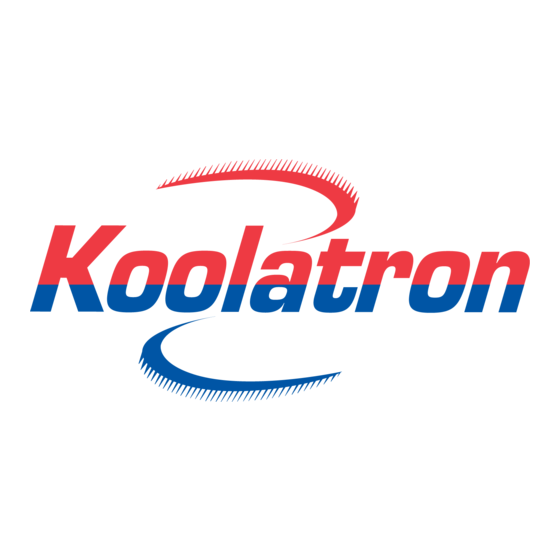Advertisement
Quick Links
Troubleshoot Guide
What level of cooling performance can we expect from a Koolatron cooler?
Each cooler should identify the cooling capabilities of that specific cooler in relation to the air
around the cooler (ambient temperature). It's best to load pre-cooled food or drinks into the
cooler.
As a rule of thumb, it takes about one hour per pound of material loaded into the cooler to
bring it from room temperature down to maximum cooling temperature. At a temperature of
80°F (27°C), the contents of the cooler can be maintained at approximately 38°F (3°C). Normal
household refrigerators are usually maintained at 45 to 48°F (7 to 9°C). At a temperature of
90°F (32 deg. C) the contents of the cooler can be maintained at approximately 48°F (9°C).
Can a Koolatron cooler freeze and make ice cubes?
Koolatron coolers don't have ice cube facilities. Operating in an air temperature below 65°F, the
contents could become frozen slowly or frozen foods could be kept solid for some time. Most
Koolatrons are not thermostatically controlled and run at maximum cold. Specialty coolers with
thermostatic controls are available for Medical, Scientific and other Premium applications.
What temperatures can be expected from the Koolatron cooler in Heater mode?
Temperatures in the range of 130 to 140°F (54.4 to 60°C). This is hot enough to bring hot food
to a pot luck dinner or a picnic. Practice safe food handling wisdom and do not keep food in the
cooler for longer than about 45 minutes. The temperatures are in the prime bacterial growth
range so it's very dangerous to store foods at these temperatures for long periods of time. If
you have a long way to go, bring the food refrigerated and cook it at the destination.
If you need dedicated Heater boxes, Koolatron can provide these (with no cooling capability)
ranging in temperatures up to 160°F (71°C). At the upper temperatures these are used for
Senior's meal delivery programs, or School meal programs. Mid range Heater boxes are used as
portable incubators for rare animals or for incubating medical swab cultures on the way to the
lab. Lower heat settings are used to keep utility workers mitts warm or for storing construction
adhesives in winter so they can be dispensed in cold weather.
Advertisement

Summary of Contents for Koolatron P85
- Page 1 Can a Koolatron cooler freeze and make ice cubes? Koolatron coolers don't have ice cube facilities. Operating in an air temperature below 65°F, the contents could become frozen slowly or frozen foods could be kept solid for some time. Most Koolatrons are not thermostatically controlled and run at maximum cold.
- Page 2 How much power is consumed by your Koolatron coolers? Most of our current production coolers consume 4.5 amps at 12 volts. The conversion is: 4.5 amps (X) times 12 volts (=) equals 54 watts. The P9 consumes only 3 amps = 36 watts. On household current the power consumed by each cooler is less than 1 amp at 120 volts.
- Page 3 How long does the cooler stay cool when unplugged? This is very dependent upon conditions. Koolatron coolers are extremely well insulated and will provide many hours of cool protection, even when switched off. Try to keep the cooler in the shade.
- Page 4 Make sure the AC adapter is plugged in. Check with a multi-meter to determine if there is at least a 12 Volt DC output voltage from the Adapter. Can we use an AC Adapter other than the one supplied by Koolatron? Not recommended and may void Warranty.
- Page 5 Make sure the fins inside and outside are free of ice and dust. If you have an questions not answered here, drop an e-mailto service@koolatron.com or call our toll free number 1-800-265-8456. Our operators are very knowledgeable, very friendly and will be...




Need help?
Do you have a question about the P85 and is the answer not in the manual?
Questions and answers